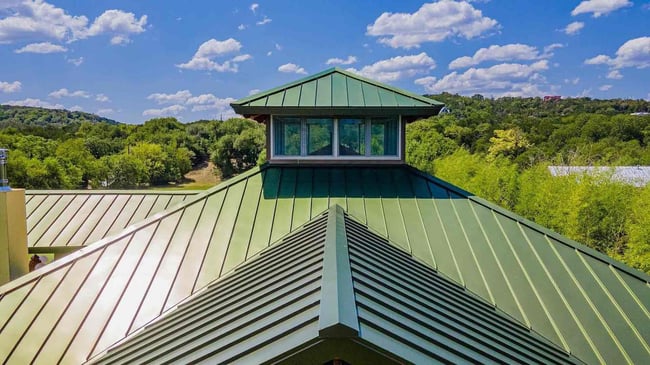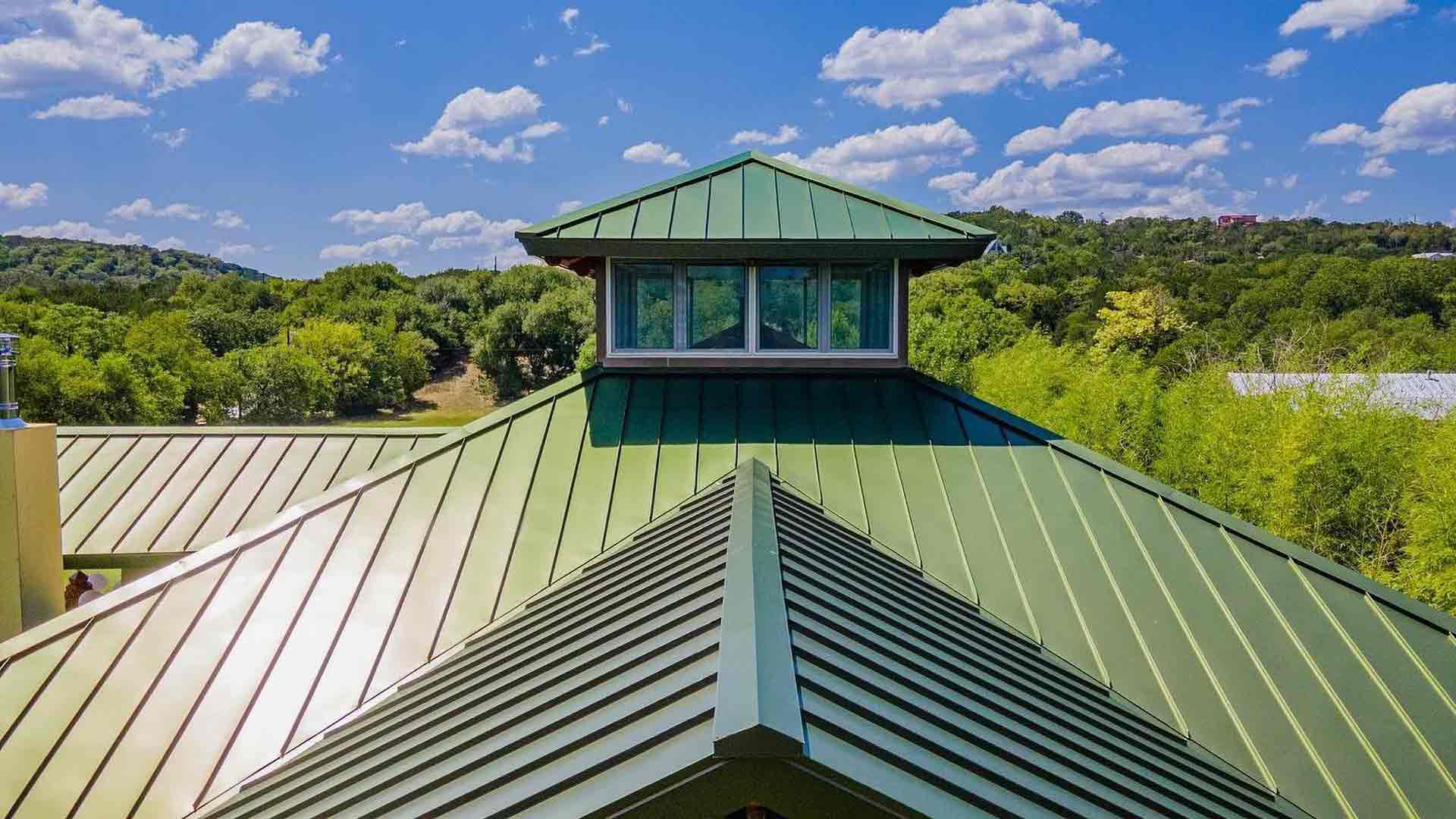What Gauge Metal Roof Is Best: 24 Gauge vs. 26 Gauge
If you’re currently picking out metal roofing, deciding on which metal gauge to use is a choice that you’ll have to make.
By the time you are focusing on the gauge, you should have already made other decisions about the type of metal roofing you’re going to buy including:
If you haven’t already picked out any of the above, we highly suggest you look at those choices first. The gauge should be one of the last decisions you make regarding your metal roofing panels.
If you need some help with these choices we suggest:
Corrugated Metal Roofing v. Standing Seam (Pros & Cons)
Best Paint For My Metal Roof Panels: SMP Paint v. PVDF
Metal Roofing Colors: 5 Tips To Pick The Best Metal Roofing Color

The reason for choosing gauge last is that it could be already decided for you based on one of the other options you choose. For example, if you want a standing seam metal roof or a flush wall siding panel, you will be automatically using 24 gauge as the sheets aren’t available in a lighter gauge.
Western States Metal Roofing has been manufacturing metal roofing and siding panels for over two decades and has helped thousands of customers choose the right metal panels for their building projects. We know from experience that one of the choices that is sometimes overlooked is which gauge metal to use.
There is no standard gauge for metal roofing. However, 24-gauge and 26-gauge are the preferred metal roofing thickness for most residential and commercial applications. There are times when one metal roofing gauge thickness is a better choice than the other.
In this article, we will go over how to choose between 24 gauge and 26 gauge metal depending on different factors such as the type of roofing panels so you have a better idea of which is best for you to use.
How Does Metal Gauge Sizing Work?
Metal gauge indicates the standard thickness of metal and is indicated by a number. As the number increases, the thickness of the metal decreases.
The most common gauge types for metal roofing are 22, 24, 26, and 29 gauge. 22 gauge is a lower number and a thicker metal than 29 gauge.
Standing Seam vs Corrugated Metal Roofing
This is the first decision that should be made prior to determining the gauge of the panel. This decision will affect which gauges are even available.
What Gauge Is Standing Seam Metal Roofing?
Standing seam has all of the best features including concealed fasteners, a PVDF paint finish, and heavy gauge steel. When you buy a standing seam roof, you’re getting a panel that’s designed to be a lifetime roof. Therefore, it’s normally in 24 gauge.
It would not make sense to purchase an expensive roof system and then manufacture it in a 26 gauge or 29 gauge metal. You’re saving very little on the overall cost of the roof, but lessening the longevity of the panel by going any lighter.
22 gauge standing seam metal roofing could be a viable option as it will decrease the chance of oil canning, but it will cost you about 20% more. It’s uncommon and normally unnecessary to use anything heavier than 24 gauge.
Corrugated Metal Roofing Thickness
There is not a standard gauge for an exposed fastener metal roofing system. The primary factor in determining the correct gauge is based upon whether the panel is installed on a solid wood substrate or spanning from support to support.
Residential Metal Roofing Over A Solid Wood Substrate
This is the most common type of residential metal roofing installation. You will have a solid wood substrate, roofing underlayment, and then the panel gets installed on top of these. With this type of installation the panel does not have to support any weight.
Either 24 or 26 gauge are appropriate for this type of metal roofing installation. Each has its pros and cons that are discussed later in this article.
Metal Roofing Spanning From Support To Support
This is a roof that has either metal purlins or wood beams spaced at different distances. The panels will need to support themselves and any load that it will have to carry such as a snow load, people walking on it, etc. It will also have to withstand the wind uplift.
24 Gauge is capable of greater spans and load capacity when compared to 26 gauge. However, every job is different and load charts and uplift charts are used to determine which metal roofing gauge will handle all of the load requirements.
24 Gauge Vs. 26 Gauge Metal Roofing Thickness
Gauge numbers refer to the decimal thickness of the steel and each gauge has a range. When it comes to 24-gauge and 26-gauge, there is an approximate 30% difference in thickness between the two metals.
When you apply a paint finish to the base metal it will increase the overall thickness of the metal. The metal roofing gauge thickness is based upon the base metal before the paint has been applied.
Refer to the chart below for thickness ranges of each gauge.
| 24 Gauge | 26 Gauge | |
| Thickness (in inches) | .0239" - .0276" | .0179" - .0217" |
Weight Of Metal Roofing Panels
Since 24-gauge is the thicker material, it’s also the heavier material compared to 26-gauge. A 24-gauge roofing panel weighs approximately 30% more than a 26-gauge panel. Just like with thickness, the weight of each gauge also has a range.
Refer to the chart below for weight ranges of each gauge.
| 24 Gauge | 26 Gauge | |
| Weight | 1- 1.156 lbs. per square foot | .75- .9063 lbs. per square foot |
When Should You Use A Thicker Metal Roof Panel?
Panels in both 24 gauge and 26 gauge provide the durability benefits of metal. They are fire-resistant, low maintenance, and protect against corrosion. However, the thickness of a panel does make a difference in its durability and makes 24 gauge metal roofing a better choice in harsher climates.

Why Is 24 Gauge Metal Roofing Better For Climates With Snow?
If you are installing a metal roof in a harsher climate that experiences snow, heavy winds, and hail, it is best to use a thicker gauge. A 24 gauge metal roof has more strength, is more impact resistant to hail, can handle higher winds, and heavier snow loads compared to a 26 gauge metal roof.
If you are installing a metal roof in a milder climate, using a 26 gauge metal is more appropriate.
Metal Panel Paint Options Based On Gauge
As you recall, one of the decisions that should be made prior to gauge is the type of paint finish, PVDF vs SMP. PVDF paint systems fade at a lesser rate than SMP panels. This is especially important when you have a bright and vibrant color. Color fade is less noticeable on a white or tan when compared to a green or red.
PVDF Paint System And Gauge
If you decide to use a PVDF paint system it will likely only be available in a minimum of 24 gauge. 26 gauge metal roofing will not be an option in most instances.
SMP Paint System And Gauge
If you decide to save some money and buy SMP painted panels, they are normally available in 26 gauge only. If you’re able to find 24 gauge metal roofing in an SMP paint finish the selection of colors is normally limited.
Choosing the correct paint finish is a critical step in determining the gauge of the panels that will be used. We highly suggest that you check out:
Do Metal Roofs Fade Over Time?
Best Paint For My Metal Roof Panels: SMP Paint v PVDF
Decrease Oil Canning With Heavier Gauge Metal Panels
When someone is looking at your roof, they will not be able to tell the gauge of the metal. There is not a noticeable difference in appearance between the panel gauges. However, the differing compositions of the panels could lead to some differences in aesthetics.
One of metal roofing’s biggest obstacles is oil canning. The wrinkles that form on metal panels can be the result of anything from screws being over tightened during installation to simply the natural simple expansion and contraction of metal.
While oil canning is unavoidable in metal, using a thicker gauge that is less malleable helps keep it from being as easily apparent as the thicker panels are stronger.
The appearance of a 26-gauge roof is usually more affected by oil canning compared to a 24-gauge metal roof. Because of its increased thickness, a 24-gauge roof is also less likely to be dented or punctured by hail or other debris that comes in contact with the roof when compared to 26-gauge.
Metal Roofing Prices By Gauge
As you might imagine, when the panel gets thicker, it also gets more expensive. The cost of a 24 gauge metal roofing will be more than a 26 gauge.
24 Gauge Metal Roofing Prices
24 gauge metal roofing prices range anywhere from $1 to $5 per sq. ft. The price depends on the type of panel and finish you choose. Below is a price breakdown of each category.
24 Gauge Corrugated Metal Roof Cost
-
- Galvalume/Galvanized- $1 to $1.50 Per Sq. Ft.
- PVDF Painted Corrugated- $1.50 to $2 Per Sq. Ft.
- Specialty Painted Finishes- $2.50 to $3.50 Per Sq. Ft.
24 Gauge Standing Seam Metal Roof Cost
-
- Galvalume/Galvanized Cost - $1.50 to $2.50 Per Sq. Ft.
- PVDF Painted Standing Seam Cost - $2 to $4 Per Sq. Ft.
- Specialty Painted Finishes Cost - $3 to $5 Per Sq. Ft.
26 Gauge Metal Roofing Prices
26 gauge metal roofing prices range from $.75 to $1.50 per sq. ft. depending on the finish and type of panel.
26 Gauge Corrugated Metal Cost
-
- Galvalume/Galvanized Cost - $.75 to $1.25 Per Sq. Ft.
- SMP Painted Corrugated Cost - $1 to $1.50 Per Sq. Ft.
26 Gauge Standing Seam Panels Cost
-
- Very Limited Availability
- Very Limited Availability
Metal Roof Gauge Chart
| 24 Gauge Panel | 26 Gauge Panel | |
| Thickness | .0239 - .0276 | .0179- .0217 |
| Weight | 1.00- 1.156 lbs per sq. ft. | .75- .9063 lbs per sq. ft. |
| Cost | $1.00 to $5.00 per sq. ft. | $.75 to $1.50 per sq. ft. |
| Paint Finish | PVDF | SMP and PVDF |
Should You Use 24 Gauge Or 26 Gauge Metal Panels For Residential Roofing?
While thicker panels are more durable, they are also more expensive and are not a necessity for every home.
Below are some general guidelines on when it’s best to use each panel:
You Should Use 24 Gauge Metal Panels If:
-
- Your roof is being installed in a climate with extreme weather conditions (hail, strong winds, heavy snow) where a thicker, more durable panel is required.
- Appearance is a top priority and you want the product with greater resistance to oil canning and dents from hail storms.
- The metal roofing is spanning from support to support and requires a heavier gauge thickness.
- You will be purchasing a standing seam metal roof.
- You will be using a PVDF paint system.
You Should Use 26 Gauge Metal Panels If:
-
- Cost is a primary concern and you are looking for a more affordable product.
- The roof is going to be located in a more mild climate that does not experience snow, hail, or storm conditions often.
- You have a commercial or agricultural job.
- You will be purchasing an exposed fastener metal roofing panel.
- You will be using an SMP paint system.
Choosing The Right Metal Roofing Color
We talked about the three decisions that should be made prior to choosing the best gauge metal roofing. We touched upon all of them except choosing a metal roofing color. This is both the most exciting and difficult decision that has to be made. Once you choose your color, you're stuck with it as metal roofing is difficult to repaint.
The first step is getting familiar with the different types of colors and finishes. You will have color charts to choose from that will display four different types of finishes and colors.
Metal Roofing Color Cards
At Western States Metal Roofing, we manufacture metal panels ranging from 20 to 26 gauge. We supply roofing and siding for residential and commercial buildings in all different types of climates and understand that some areas have conditions that require a certain gauge.
If you need assistance deciding which gauge is best for your project, our knowledgeable team is here to help.
We recommend that you get a quote from more than one company. You want a company that has great google reviews and a fair price. Our online form is quick and easy to fill out. Start the process of picking out your panels by requesting a quote.







